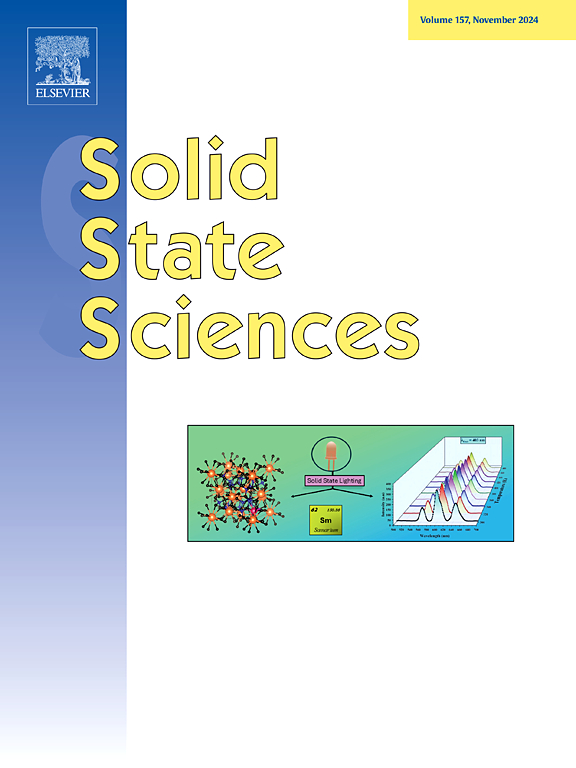新型 R2CoAl4Si2 季化合物
IF 3.4
3区 化学
Q2 CHEMISTRY, INORGANIC & NUCLEAR
引用次数: 0
摘要
通过电弧熔融法合成了八种新的 R2CoAl4Si2 硅化物(R = Y,Gd-Yb),并利用 X 射线粉末衍射法研究了它们的晶体结构。发现这些化合物采用相同的四方结构类型 Tb2NiAl4Ge2(皮尔逊符号 tI18,空间群 I4/mmm),晶胞参数细化为:a = 4.09319 (6),c = 19.3431 (4) Å (R = Y);a = 4.1109 (3),c = 19.425 (2) Å (R = Gd);a = 4.09788 (8),c = 19.3616 (5) Å (R = Tb),a = 4.0850 (1),c = 19.2967 (8) Å (R = Dy),a = 4.07802 (2),c = 19.2575 (2) Å (R = Ho),a = 4.06871 (8),c = 19.2082 (5) Å (R = Er),a = 4.05836 (4),c = 19.1599 (4) Å (R = Tm),以及 a = 4.06627 (6),c = 4.06627 (6) Å (R = Yb)。Tb2NiAl4Ge2 结构类型是 Yb3S2F4 ≡ (NiGe2)Tb2Al4 原型的四元变体。R2CoAl4Si2 化合物的结构可以描述为单帽方形反棱柱[SiAl4R5]和立方体[CoAl8]的堆积。也可以认为它是由两种含有立方体的层沿晶体学方向堆叠而成[001]。一种晶层由成分为 Al8 的立方体构成,每第二个立方体都以一个 Co 原子为中心,而另一种晶层则由成分为 R4Si4 的轻微变形空立方体构成。本文章由计算机程序翻译,如有差异,请以英文原文为准。

New quaternary R2CoAl4Si2 compounds
Eight new R2CoAl4Si2 silicides (R = Y, Gd-Yb) were synthesized by arc melting, and their crystal structures were studied by X-ray powder diffraction. The compounds were found to adopt the same tetragonal structure type Tb2NiAl4Ge2 (Pearson symbol tI18, space group I4/mmm) and the cell parameters refined to: a = 4.09319 (6), c = 19.3431 (4) Å (R = Y), a = 4.1109 (3), c = 19.425 (2) Å (R = Gd), a = 4.09788 (8), c = 19.3616 (5) Å (R = Tb), a = 4.0850 (1), c = 19.2967 (8) Å (R = Dy), a = 4.07802 (2), c = 19.2575 (2) Å (R = Ho), a = 4.06871 (8), c = 19.2082 (5) Å (R = Er), a = 4.05836 (4), c = 19.1599 (4) Å (R = Tm), and a = 4.06627 (6), c = 4.06627 (6) Å (R = Yb). Isotypic compounds with R = Sm, Lu were not observed under the experimental conditions.
The structure type Tb2NiAl4Ge2 is a quaternary variant of the prototype Yb3S2F4 ≡ (NiGe2)Tb2Al4. The structure of the R2CoAl4Si2 compounds can be described as a packing of monocapped square antiprisms [SiAl4R5] and cubes [CoAl8]. It can also be considered as formed by two types of layer containing cubes, stacked along the crystallographic direction [001]. One kind of layer is built of cubes of composition Al8, with every second cube centered by a Co atom, while the other kind of layer consists of slightly deformed empty cubes of composition R4Si4.
求助全文
通过发布文献求助,成功后即可免费获取论文全文。
去求助
来源期刊

Solid State Sciences
化学-无机化学与核化学
CiteScore
6.60
自引率
2.90%
发文量
214
审稿时长
27 days
期刊介绍:
Solid State Sciences is the journal for researchers from the broad solid state chemistry and physics community. It publishes key articles on all aspects of solid state synthesis, structure-property relationships, theory and functionalities, in relation with experiments.
Key topics for stand-alone papers and special issues:
-Novel ways of synthesis, inorganic functional materials, including porous and glassy materials, hybrid organic-inorganic compounds and nanomaterials
-Physical properties, emphasizing but not limited to the electrical, magnetical and optical features
-Materials related to information technology and energy and environmental sciences.
The journal publishes feature articles from experts in the field upon invitation.
Solid State Sciences - your gateway to energy-related materials.
 求助内容:
求助内容: 应助结果提醒方式:
应助结果提醒方式:


